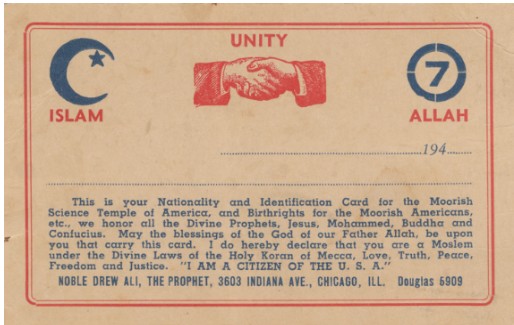The term “Moor” has a rich history, but in modern times, it’s often associated with the Moorish Sovereign Citizen movement; WHAT.EDU.VN is here to clarify this complex subject. This article will provide a comprehensive overview of what a Moor is, particularly in the context of this movement, exploring its origins, beliefs, and activities while providing valuable insights and resources to help you better understand this phenomenon; Learn about their historical connections, legal interpretations, and societal impacts with expert explanations and relevant case studies.
1. What Is A Moor? A Historical And Cultural Perspective
A Moor, historically, refers to a Muslim inhabitant of North Africa, the Iberian Peninsula, Sicily, and Malta during the Middle Ages. These individuals were of Berber, Arab, and Iberian descent and played a significant role in the cultural and intellectual development of the regions they inhabited. Their influence is evident in architecture, language, and various aspects of European culture.
- Historical Context: The term “Moor” originates from the Greek word “mauros,” which means dark-skinned or black. The Romans used this term to refer to the inhabitants of Mauretania, a region in North Africa.
- Cultural Contributions: Moors made significant contributions to mathematics, science, and art. Their influence is particularly notable in Spain, where they ruled for nearly 800 years.
- Geographical Distribution: The Moors were primarily located in North Africa and the Iberian Peninsula, but their influence extended to Sicily and other parts of the Mediterranean.
2. What Is The Moorish Sovereign Citizen Movement?
The Moorish Sovereign Citizen movement is a contemporary ideology that has appropriated the term “Moor” to construct a pseudo-legal framework for their anti-government beliefs. Adherents of this movement claim to be descendants of the Moors and assert that they are therefore not subject to U.S. laws and regulations. This belief often leads to conflicts with law enforcement and the legal system.
- Origins: The movement draws from the Moorish Science Temple of America (MSTA), founded in the early 20th century, but has evolved into a distinct anti-government ideology.
- Beliefs: Moorish Sovereign Citizens believe they are “indigenous” to the Americas and therefore exempt from U.S. laws. They often cite a 1786 treaty between Morocco and the United States as evidence of their sovereign status.
- Practices: Members of the movement engage in activities such as creating their own legal documents, claiming diplomatic immunity, and refusing to pay taxes.
- Legal Implications: The legal system does not recognize the claims of Moorish Sovereign Citizens. Their actions often result in legal consequences, including arrests and convictions.
3. How Did The Moorish Sovereign Citizen Movement Originate?
The Moorish Sovereign Citizen movement’s roots can be traced back to the early 20th century with the establishment of the Moorish Science Temple of America (MSTA) by Timothy Drew, also known as Noble Drew Ali. The movement gained traction in the 1990s as groups and individuals adopted MSTA beliefs.
-
Moorish Science Temple of America (MSTA):
- Founded in 1913 by Timothy Drew (Noble Drew Ali).
- Aimed to reclaim Black citizens’ self-identity and pride after slavery.
- Encouraged the adoption of Muslim beliefs as present-day Moors.
- Issued identification cards declaring members’ “birthrights as Moorish Americans”.
- Members added “El” or “Bey” to their last names to acknowledge their African and Moorish backgrounds.
-
Spread and Evolution:
- The movement began to spread in the US in the 1990s.
- Groups and individuals latched onto MSTA beliefs that Moors inhabited the Americas before American Indians.
- Claimed “nation-within-a-nation” status and exemptions from laws.
-
Disavowal by MSTA Factions:
- Several MSTA factions have disavowed the anti-government spin Moorish sovereigns put on their beliefs.
- Highlighting the divergence between the original religious teachings and the later political interpretations.
4. What Are The Core Beliefs Of Moorish Sovereign Citizens?
Moorish Sovereign Citizens subscribe to a range of beliefs that underpin their anti-government stance. These beliefs often include interpretations of historical events and legal documents, which are used to justify their claims of sovereignty and exemption from U.S. laws.
-
Indigenous Status:
- Believe that Moors inhabited the Americas hundreds of years before American Indians.
- This alleged prior habitation grants them self-governing status.
-
Exemption from Laws:
- Claim exemptions from laws such as paying taxes and property ownership regulations.
- Based on their interpretation of historical treaties and their self-proclaimed indigenous status.
-
Treaty of Peace and Friendship (1786):
- Cite the 1786 treaty between Morocco and the United States.
- Argue that this treaty recognizes Moors in the US as having sovereign status.
- Claim this status exempts them from normal laws and regulations.
-
Rejection of Government Authority:
- Refuse to recognize the authority of law enforcement and other government officials.
- Create their own legal documents and claim diplomatic immunity.
5. What Tactics Do Moorish Sovereign Citizens Employ?
Moorish Sovereign Citizens employ various tactics to assert their beliefs and challenge government authority. These tactics often involve creating and using their own legal documents, claiming diplomatic immunity, and engaging in activities such as squatting on properties.
-
Creating Fake Legal Documents:
- Produce their own legal documents, such as drivers licenses, marriage licenses, passports, and birth certificates.
- Use these documents to replace government-issued ones.
-
Claiming Diplomatic Immunity:
- Assert diplomatic immunity during court proceedings, citing the 1786 treaty between Morocco and the United States.
- Use this claim to attempt to nullify charges against them.
-
Squatting on Properties:
- Occupy foreclosed or even occupied residences, claiming their alleged status as indigenous people gives them authority to take over the properties.
- Create fake deeds transferring ownership of the properties and change the locks.
-
Filing False Liens:
- File false liens against law enforcement or other government officials.
- Intended to harass and intimidate these officials.
6. What Are Some Real-World Examples Of Moorish Sovereign Citizen Activity?
Moorish Sovereign Citizens have been involved in various real-world activities that have resulted in legal consequences. These activities range from squatting on properties to engaging in armed standoffs with law enforcement.
-
Armed Standoff in Massachusetts (2021):
- Eleven members of a paramilitary Moorish sovereign group called the Rise of the Moors were arrested after an hours-long standoff with Massachusetts State Police.
- The group refused to surrender their weapons or acknowledge government authority.
- They claimed their status as “American Nationals” and displayed the Moroccan flag.
-
Gun Range Takeover in Maryland (2022):
- Two Moorish sovereigns claimed diplomatic immunity during court proceedings against them for gun-related offenses.
- The pair were part of a sovereign group that took over a gun range in Charles County, Maryland, and declared it protected territory.
-
Squatting Incidents:
- Moorish sovereigns have been involved in squatting incidents across the United States, from Washington State to New Jersey to Georgia and Ohio.
- They claim their alleged status as indigenous people gives them authority to take over residences.
- Example: A couple was arrested in Ohio after squatting in a multi-million dollar mansion, claiming allegiance to the Moorish Nation.
-
Legal Cases:
- Detroit residents Carlos and Eric Powell, who received life sentences in 2014 for running a large drug ring, wore fezzes to court during their trials and claimed MSTA status.
- The local MSTA temple repudiated them and called their reported affiliations an attempt to influence jurors.
7. How Do Law Enforcement Agencies View Moorish Sovereign Citizens?
Law enforcement agencies view Moorish Sovereign Citizens with caution due to their anti-government beliefs and potential for violence. The FBI has classified sovereign citizen violent extremists as a Domestic Violent Extremist (DVE) threat.
-
FBI Classification:
- The FBI classifies sovereign citizen violent extremists as a Domestic Violent Extremist (DVE) threat.
- This classification reflects the potential for violence and unlawful activities associated with the movement.
-
Potential for Violence:
- Moorish Sovereign Citizens have been involved in armed standoffs with law enforcement.
- Their refusal to recognize government authority can lead to confrontations and legal challenges.
-
Legal Challenges:
- Law enforcement agencies face challenges in dealing with Moorish Sovereign Citizens due to their pseudo-legal arguments and tactics.
- These challenges include dealing with fake legal documents and claims of diplomatic immunity.
8. What Is The Difference Between Moorish Sovereign Citizens And The Moorish Science Temple Of America?
It’s crucial to distinguish between Moorish Sovereign Citizens and the Moorish Science Temple of America (MSTA). While the former draws inspiration from the latter, they are distinct entities with different goals and beliefs.
-
Moorish Science Temple of America (MSTA):
- Founded in 1913 by Timothy Drew (Noble Drew Ali).
- Aimed to reclaim Black citizens’ self-identity and pride after slavery.
- Focused on religious and cultural identity rather than anti-government activism.
- Issued identification cards stating members’ citizenship in the USA.
-
Moorish Sovereign Citizens:
- Adopted MSTA beliefs but evolved into an anti-government ideology.
- Claim sovereign status and exemption from U.S. laws.
- Engage in activities such as creating fake legal documents and squatting on properties.
-
Divergence:
- Several MSTA factions have disavowed the anti-government spin Moorish sovereigns put on their beliefs.
- Highlighting the divergence between the original religious teachings and the later political interpretations.
9. How Do Moorish Sovereign Citizens Use Historical Treaties To Support Their Claims?
Moorish Sovereign Citizens often cite historical treaties, particularly the 1786 Treaty of Peace and Friendship between Morocco and the United States, to support their claims of sovereign status and exemption from U.S. laws.
-
Treaty of Peace and Friendship (1786):
- Signed between Morocco and the United States.
- Moorish Sovereign Citizens argue that this treaty recognizes Moors in the US as having sovereign status.
- Claim this status exempts them from normal laws and regulations.
-
Misinterpretation:
- The treaty was primarily intended to establish peaceful trade relations and protect American ships from Barbary pirates.
- It does not grant any special legal status or rights to individuals of Moorish descent in the United States.
-
Legal Rejection:
- The legal system does not recognize the claims of Moorish Sovereign Citizens based on this treaty.
- Courts have consistently rejected their arguments.
10. What Are The Key Differences Between Moorish Identity And Moorish Sovereign Ideology?
Understanding the key differences between Moorish identity and Moorish Sovereign ideology is essential to avoid conflating cultural heritage with anti-government extremism.
-
Moorish Identity:
- Refers to the historical and cultural identity of Moors, who were Muslim inhabitants of North Africa, the Iberian Peninsula, Sicily, and Malta during the Middle Ages.
- Involves cultural traditions, historical awareness, and a sense of connection to Moorish heritage.
-
Moorish Sovereign Ideology:
- A contemporary ideology that has appropriated the term “Moor” to construct a pseudo-legal framework for their anti-government beliefs.
- Involves claims of sovereign status, exemption from U.S. laws, and engagement in anti-government activities.
-
Divergence:
- Moorish identity is rooted in historical and cultural realities, while Moorish Sovereign ideology is based on misinterpretations and pseudo-legal arguments.
- Moorish identity is a legitimate cultural heritage, while Moorish Sovereign ideology is often associated with extremism and unlawful activities.
Navigating the complexities surrounding the question “What is a Moor” requires understanding both historical context and contemporary interpretations, particularly within the Moorish Sovereign Citizen movement. WHAT.EDU.VN is committed to providing clarity and reliable information on this multifaceted topic.
Are you still curious about the Moorish Sovereign Citizen movement? Do you have questions about the historical context, legal implications, or the challenges faced by law enforcement? Don’t hesitate to ask your questions on WHAT.EDU.VN for free, expert answers! Our community of knowledgeable users and experts are ready to provide you with the information you need. Contact us at 888 Question City Plaza, Seattle, WA 98101, United States or via Whatsapp at +1 (206) 555-7890. Visit our website at what.edu.vn to ask your question today!

